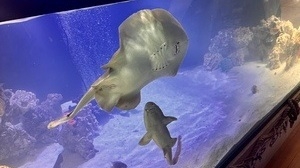How did a solo stingray in a N.C. aquarium get pregnant? : NPR

Charlotte the pregnant stingray swims in her aquarium in Hendersonville, N.C.
Lydia Wilson
hide caption
toggle caption
Lydia Wilson
A big announcement came out of a small aquarium nestled in the Appalachian mountain city of Hendersonville, N.C., on Feb. 8.
Charlotte the round stingray is pregnant with multiple pups despite there being no male of her species in her tank. Caretakers thought the ray, who’s thought to be between 12 and 14 years old, hadn’t been with a mate in more than eight years.
The internet loves a mystery, and Charlotte became an instant celebrity.
Social media followers from around the world tuned into a livestream of her ultrasound at the Aquarium & Shark Lab that was broadcast by Team Ecco.
Founder Brenda Ramer stood in the foreground, while other staff held the dinner plate-sized beige ray for examination. The modest 2,200 gallon aquarium is big enough for a person to kneel in but still small enough to fit into a restaurant for decoration.
“We found out that Charlotte is expecting,” Ramer said on the social media livestream. “It’s a really unique and strange phenomenon to happen. We don’t have a male ray.”
Ramer, a former teacher, founded the aquarium in her kitchen in 2001 and says her mission was to bring excitement about marine biology to North Carolina mountain kids.

The small aquarium in Hendersonville, N.C., is seeing a lot of visitors curious about Charlotte the pregnant stingray.
Lydia Wilson
hide caption
toggle caption
Lydia Wilson

The small aquarium in Hendersonville, N.C., is seeing a lot of visitors curious about Charlotte the pregnant stingray.
Lydia Wilson
Mission accomplished. The story has garnered so much attention that it’s been covered by international news and late night comedy shows, everyone wanting to know how Charlotte got pregnant.
“At this point there is no answer,” said Demian Chapman, who directs the Sharks & Rays Conservation Research Program at the Mote Institute in Florida, “but it fits all the parameters … for parthenogenesis.”
What most likely happened is that Charlotte impregnated herself through an asexual reproduction process, Chapman says. In parthenogenesis, when a female produces eggs, an egg byproduct with nearly the same DNA fuses back with the eggs instead of a male fertilizing them.
“It’s something we’ve only known about for under two decades in sharks and rays,” Chapman says.
There’s another conception theory. There were two male white-spotted bamboo sharks in Charlotte’s tank, according to Ramer. She says they started seeing bite marks on Charlotte, possibly indicating a shark mating behavior.
“It’s very unlikely [the ray and a shark] could have hybridized,” says Warren Booth an associate professor of entomology at Virginia Tech. He’s a go-to DNA tester to solve cases like Charlotte’s. “Even though they’re both Elasmobranchs, I think they’re so genetically distant that that is not considered possible.”
Unfortunately, according to Booth, offspring birthed in captivity through asexual parthenogenesis don’t really advance wildlife conservation efforts.
“Parthenogenesis has a tendency to produce offspring that are not very healthy,” Booth says. “In all of the studies in snakes, birds, sharks, the offspring don’t survive very long. They’re stillborn or they expire within a short amount of time.”
Parthenogens are, therefore, the most inbred of nature’s babies. Known subjects have survived days to seven years, according to recent research.
“The media excitement does educate the public about this system and that it’s something that’s actually occurring,” Booth says. “But I think it’s completely the opposite of beneficial to conservation. Whenever the level of genetic diversity is greatly diminished, the less likely the species will be able to adapt to changing environments.”
It’s been a month since Charlotte’s pregnancy announcement, and social media commenters are antsy — followers are ready to see babies.
But even a birth won’t immediately resolve how Charlotte got pregnant. The Field Museum of Natural History in Chicago will perform a DNA test on the pups to show conclusive results. That test could take a week or more.
Until then, the secret lies with Charlotte.




